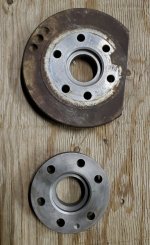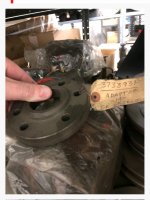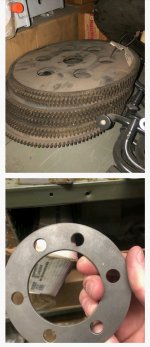1BG,
I'm late to this thread...
That fifth wheel plate is "ugly". And being made of T1 steel they should be plenty strong....
I haven't looked lately at the bell housing on my 1986 1544 (360 Industrial with AT545), but from memory it looks different than yours. My recollection of a conversation with Tucker's Jeff Godard is that Tucker had the bell housings made specially for them by a company in Oregon. AT545s were used extensively for many years and behind many different engines, both gas and Diesel. That said, I looked pretty hard and have NEVER found an AT545 (SAE #3 pattern) to a Chrysler LA engine (318 and 360 pattern) adapter housing other than in a Tucker. I wouldn't bet my life on it, but I don't believe Chrysler offered a vehicle with an LA engine and an AT545 transmission as a power train option.
BUT, Chrysler did offer a school bus chassis to bus manufacturers such as Carpenter, Thomas, Wayne and Blue Bird, and it could be spec'd with a 318 and an Allison MT30 transmission. The MT30 is a six speed automatic, but it uses the same SAE #3 bolt pattern.
I also know Tucker has worked closely with the Allison dealer in developing/refining the engine transmission interface. From memory, so I could easily be wrong, that company is Pacific Power Group. I spoke with a very helpful guy there a number of years ago. I THINK his last name was Edwards, and his first name was John, but I could be wrong about that, too. He may be able to help...
Best of luck with the stroker project!
I'm late to this thread...
That fifth wheel plate is "ugly". And being made of T1 steel they should be plenty strong....
I haven't looked lately at the bell housing on my 1986 1544 (360 Industrial with AT545), but from memory it looks different than yours. My recollection of a conversation with Tucker's Jeff Godard is that Tucker had the bell housings made specially for them by a company in Oregon. AT545s were used extensively for many years and behind many different engines, both gas and Diesel. That said, I looked pretty hard and have NEVER found an AT545 (SAE #3 pattern) to a Chrysler LA engine (318 and 360 pattern) adapter housing other than in a Tucker. I wouldn't bet my life on it, but I don't believe Chrysler offered a vehicle with an LA engine and an AT545 transmission as a power train option.
BUT, Chrysler did offer a school bus chassis to bus manufacturers such as Carpenter, Thomas, Wayne and Blue Bird, and it could be spec'd with a 318 and an Allison MT30 transmission. The MT30 is a six speed automatic, but it uses the same SAE #3 bolt pattern.
I also know Tucker has worked closely with the Allison dealer in developing/refining the engine transmission interface. From memory, so I could easily be wrong, that company is Pacific Power Group. I spoke with a very helpful guy there a number of years ago. I THINK his last name was Edwards, and his first name was John, but I could be wrong about that, too. He may be able to help...
Best of luck with the stroker project!







